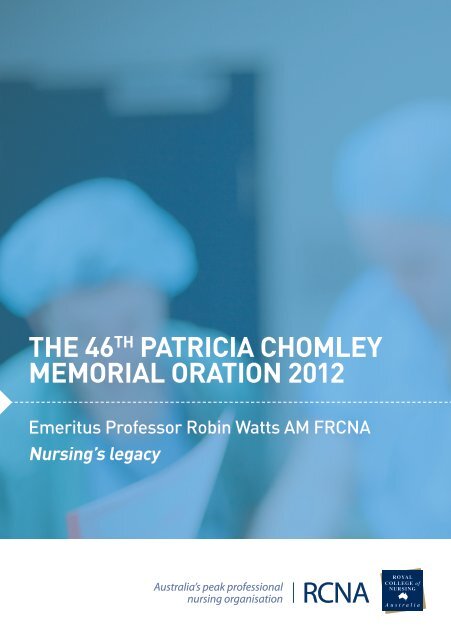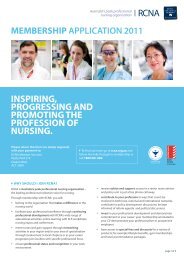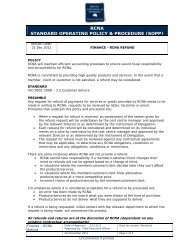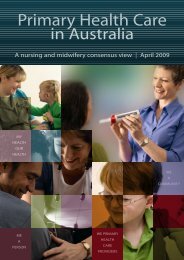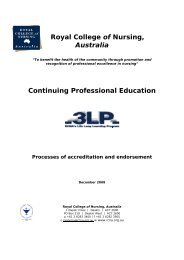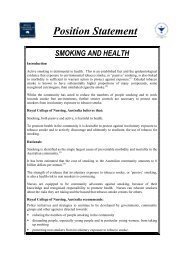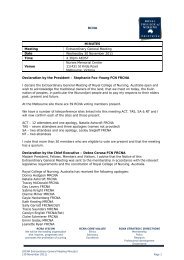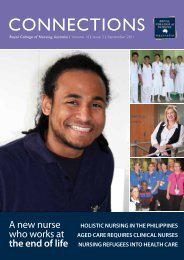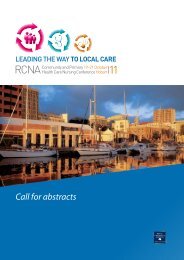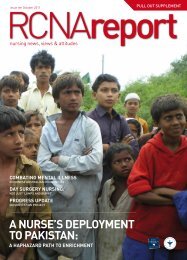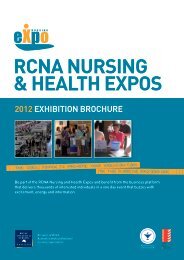the 46th patricia chomley memorial oration 2012 - Royal College of ...
the 46th patricia chomley memorial oration 2012 - Royal College of ...
the 46th patricia chomley memorial oration 2012 - Royal College of ...
You also want an ePaper? Increase the reach of your titles
YUMPU automatically turns print PDFs into web optimized ePapers that Google loves.
23 May <strong>2012</strong>Rcna National ConferenceClinical And Corporate Governance
OrationRCNAThe <strong>46th</strong> Patricia Chomley Memorial OratorEmeritus Pr<strong>of</strong>essor Robin Watts AM FRCNAPhD(Colorado) MHSc(McMaster) BA(WAIT) Dip NEd(CoN, Aust) RNPr<strong>of</strong>essor Watts is an Emeritus Pr<strong>of</strong>essor <strong>of</strong> Nursing, CurtinUniversity and a Director <strong>of</strong> <strong>the</strong> Western Australian Centre forEvidence Informed Healthcare Practice, a collaborating centre<strong>of</strong> <strong>the</strong> Joanna Briggs Institute. She has been involved in nursingeducation for 42 years and served on or chaired numerousnational and state nursing education committees, reviews andprojects.Pr<strong>of</strong>essor Watts commenced her basic nursing training at PrincessMargaret Hospital for Children (PMH) in 1962. Following hergraduation in 1965, Robin undertook her midwifery training at <strong>the</strong><strong>Royal</strong> North Shore Hospital in Sydney before travelling overseaswhere she gained valuable nursing experience in both Canada and <strong>the</strong> <strong>the</strong>n war torn Honduras.Upon her return to Australia in 1971, Pr<strong>of</strong>essor Watts undertook her Diploma <strong>of</strong> Nursing Education at<strong>the</strong> <strong>Royal</strong> <strong>College</strong> <strong>of</strong> Nursing in Melbourne and in 1973 accepted an appointment as <strong>the</strong> Senior NurseEducator in <strong>the</strong> School <strong>of</strong> Nursing at PMH for Children. Following <strong>the</strong> transition <strong>of</strong> nursing educationto <strong>the</strong> tertiary sector, she left <strong>the</strong> hospital in 1976 to take up a Lecturer’s position in paediatric nursingin <strong>the</strong> School <strong>of</strong> Nursing at <strong>the</strong> Western Australian Institute <strong>of</strong> Technology (now Curtin University).Although promoted to various administrative positions within <strong>the</strong> university since <strong>the</strong>n, Pr<strong>of</strong>essorWatts has always maintained a close interest in <strong>the</strong> quality <strong>of</strong> health care provided for children in allhealth care settings in Western Australia and beyond.Pr<strong>of</strong>essor Watts’ contribution to <strong>the</strong> nursing pr<strong>of</strong>ession has been and continues to be immense.Of particular note is her involvement with <strong>the</strong> Australian Health Ethics Committee, <strong>the</strong> AustralianCouncil <strong>of</strong> Deans <strong>of</strong> Nursing, <strong>the</strong> National Review <strong>of</strong> Nursing Education, management <strong>of</strong> <strong>the</strong> SharedHealth Interactive Practice initiative and her work as <strong>the</strong> Director <strong>of</strong> <strong>the</strong> WA Centre for Evidence BasedNursing and Midwifery. These are current examples <strong>of</strong> her leadership and ongoing desire to progress<strong>the</strong> nursing pr<strong>of</strong>ession.The <strong>46th</strong> Patricia Chomley Memorial Oration <strong>2012</strong>RCNA1
<strong>the</strong> Patricia Chomley Memorial OrationEstablished in 1966, <strong>the</strong> Patricia Chomley Memorial Oration has become part <strong>of</strong> tradition at <strong>Royal</strong><strong>College</strong> <strong>of</strong> Nursing, Australia (RCNA) and has been presented annually to honour Miss PatriciaChomley, <strong>the</strong> first Director <strong>of</strong> <strong>the</strong> <strong>College</strong> <strong>of</strong> Nursing, Australia (now known as RCNA).Appointed in 1949, Miss Chomley was director until her retirement from <strong>the</strong> position in 1964.During <strong>the</strong> 15 years <strong>of</strong> Miss Chomley’s leadership, some six hundred students undertook courses.Many <strong>of</strong> those nurses subsequently held responsible positions throughout Australia and wereinstrumental in important developments in <strong>the</strong> nursing pr<strong>of</strong>ession and in upgrading <strong>the</strong> quality <strong>of</strong>patient care.Miss Chomley passed away on 24 October 2002 and <strong>the</strong> Patricia Chomley Memorial Oration is afitting tribute to her leadership and contribution to RCNA.Past Orators1966 Pr<strong>of</strong>essor J A Ovenstone – Automation and its implications in Australia1967 Dr Phillip Law – The changing pattern <strong>of</strong> requirements in pr<strong>of</strong>essional education1968 Pr<strong>of</strong>essor R A Rodda – Pioneer nurses: Then and now1969 Miss Patricia Church – After twenty years – A pause for reflection1970 Reverend Mo<strong>the</strong>r Lois – The changing status <strong>of</strong> pr<strong>of</strong>essional women1971 Mrs Joanna Wilkinson – Introduction to <strong>the</strong> concept <strong>of</strong> <strong>the</strong> group care unit into pr<strong>of</strong>essionalnurse training1972 Mr M H Bone – Lifelong learning: The role <strong>of</strong> permanent education in <strong>the</strong> education system1973 Pr<strong>of</strong>essor R M Mitchell – Nursing and modern medicine1974 Miss Beatrice Salmon – Pragmatic axles turn on emptiness1975 Sir Paul Hasluck – What is <strong>the</strong> use <strong>of</strong> history?1976 Miss Patience R Thomas – The role <strong>of</strong> women over three centuries1977 Pr<strong>of</strong>essor David Madison – Coping with crisis: A challenge for <strong>the</strong> health pr<strong>of</strong>ession1978 Dr John R Sabine – A jug <strong>of</strong> wine, a loaf <strong>of</strong> bread and thou1979 Mr James P Smith – Nursing needs a pr<strong>of</strong>essional renaissance1980 Miss Rosalie Pratt FRCNA – A time for every purpose...1981 Dr Rosemary Crow – How nursing and <strong>the</strong> community can benefit from nursing research1982 Miss Patricia V Slater FRCNA FCN (NSW) – The role <strong>of</strong> nursing organisations in pr<strong>of</strong>essionaleducation – Challenges for <strong>the</strong> future1983 Miss Bartz Schultz FRCNA – Founders <strong>of</strong> <strong>the</strong> <strong>College</strong>1984 Pr<strong>of</strong>essor Baronees McFarlane <strong>of</strong> Llandaff – Nursing – Fit for <strong>the</strong> future?2 RCNA The <strong>46th</strong> Patricia Chomley Memorial Oration <strong>2012</strong>
Nursing’s legacyMadam President, distinguished guests and colleagues. It is a particular honour to have beeninvited to present what will be, given <strong>the</strong> amalgamation <strong>of</strong> <strong>the</strong> two nursing colleges, <strong>the</strong> finalPatricia Chomley Memorial Oration for <strong>the</strong> <strong>Royal</strong> <strong>College</strong> <strong>of</strong> Nursing, Australia. What an eminentlysensible legacy to hand on to <strong>the</strong> following generations <strong>of</strong> nurses – a single national pr<strong>of</strong>essionalorganisation!As in any year, this year (<strong>2012</strong>) has some major anniversaries to celebrate. Some <strong>of</strong> <strong>the</strong>se are <strong>of</strong>particular interest and/or importance. The Queen for example has reigned over us for 60 years, whileMawson and his men traversed Antarctica 100 years ago. Quite different achievements but both haveleft or will leave a significant legacy. Terms such as ‘dedication’ and ‘tenacity’, among o<strong>the</strong>rs, spring tomind.In a recent program on Mawson and his team’s achievements, <strong>the</strong> commentator remarked: “The menhave gone but Mawson’s hut remains and so <strong>the</strong>ir legacy lives on”. 1 Does Australian nursing have asymbolic ‘hut’? If so, are we tending that legacy so it survives? Is it even a legacy that should survive?Is it rhetoric or reality, or a mix <strong>of</strong> both? There are some in <strong>the</strong> pr<strong>of</strong>ession who argue any efforts wehave made, if we made an effort at all, in this regard have been a dismal failure. Kieseker’s recentblunt assessment was that “after being central to <strong>the</strong> wellbeing <strong>of</strong> Australians for 200 years, nurseshave failed to make a mark”. 2, p.11 O<strong>the</strong>rs are more positive but whe<strong>the</strong>r we, as a national group, couldvery confidently say that we are perceived as having made a significant contribution to this country isa moot point. I wish to explore <strong>the</strong>se and o<strong>the</strong>r related issues tonight.What might we place in nursing’s symbolic ‘legacy hut’? I obviously have some suggestions whichI will present in no particular order; you may well have some o<strong>the</strong>r ideas. I should also at this pointindicate <strong>the</strong> context in which my more recent observations <strong>of</strong> what was and is happening in nursinghave been made as this inevitably influences my thoughts on this topic. Over <strong>the</strong> last 12 years Ihave been, in some ways, on <strong>the</strong> sidelines <strong>of</strong> nursing. In <strong>the</strong> eight and half years I spent in universitymanagement, only one day a week was assigned to being a nursing academic (and that was usuallySundays). I <strong>the</strong>n spent ano<strong>the</strong>r two years full time in <strong>the</strong> School <strong>of</strong> Nursing and Midwifery beforefinally retiring, only to pop up again in an adjunct position. The decision to share this aspect <strong>of</strong> mypersonal history with you was generated by a point made by a fellow orator one year ago. She was <strong>of</strong><strong>the</strong> view that nurses who take up positions that lie outside nursing, such as university managementroles or participation “in medical research <strong>of</strong> uncertain relevance to nursing … should not beautomatically endorsed by us as representative <strong>of</strong> our pr<strong>of</strong>ession”. 3, p.18 A quote from ano<strong>the</strong>r source,with one addition, that is ‘men’, and one substitution, that is ‘senior university managers’ for ‘doctors’,also resonated. This is from Helmstadter discussing nursing leadership at <strong>the</strong> end <strong>of</strong> <strong>the</strong> 19th century:4 RCNA The <strong>46th</strong> Patricia Chomley Memorial Oration <strong>2012</strong>
OrationRCNA“... <strong>the</strong> compromise on nursing education <strong>the</strong>se women made with <strong>the</strong> doctors in order togain rank and a higher social station placed <strong>the</strong>m in an impossible position in terms <strong>of</strong> <strong>the</strong>ir4, p.189pr<strong>of</strong>essional aspirations, leading <strong>the</strong>m into all kinds <strong>of</strong> inner contradictions.”These two statements led to some reflection on my part but my conclusion was that nursing hasalways been absolutely core to me and that my experience as a nurse, in a somewhat uniqueposition as executive director <strong>of</strong> university planning, may well have provided me with someuseful insights that I could contribute to <strong>the</strong> debate. I will leave it up to you to decide whe<strong>the</strong>r myobservations have any degree <strong>of</strong> credibility.What immediately comes to mind is <strong>the</strong> significant numbers <strong>of</strong> educated individuals nursing hasprovided Australia with. I am not confining this legacy just to <strong>the</strong> period from <strong>the</strong> advent <strong>of</strong> tertiaryeducation for nurses 38 years ago – as an aside you will note that we are edging ever closer to halfa century here. The foundations <strong>of</strong> this legacy were put in place by a small number <strong>of</strong> nurses whowent to <strong>the</strong> UK to study for qualifications in nursing education and administration, <strong>the</strong>n built onby <strong>the</strong> <strong>College</strong> <strong>of</strong> Nursing era here in Australia – <strong>the</strong> <strong>of</strong>t quoted 600 graduates in Patricia Chomley’sera and many more after that. Add to that <strong>the</strong> recipients <strong>of</strong> <strong>the</strong> Kellogg Foundation scholarshipsfor study in North America in <strong>the</strong> 1980s. Then <strong>the</strong>re are <strong>the</strong> nurses who gained higher degrees innursing overseas and/or university qualifications in o<strong>the</strong>r disciplines both before and after <strong>the</strong> advent<strong>of</strong> postgraduate nursing degrees. Finally <strong>the</strong>re are those who educated <strong>the</strong>mselves, in spite <strong>of</strong> <strong>the</strong>constraints <strong>of</strong> <strong>the</strong>ir training. 5 Not bad for nice, kind girls (and boys) who didn’t need to be bright.The impact <strong>of</strong> tertiary nursing education in this respect is most evident in <strong>the</strong> number enrolling inuniversity at undergraduate level once <strong>the</strong> transfer was completed. The most recent figures available– 2009 – for domestic students enrolled in courses leading to initial registration as a nurse were 33489, an increase <strong>of</strong> 6.5% for females and 5.3% for males from <strong>the</strong> previous year. 6 Many <strong>of</strong> <strong>the</strong>se wouldbe <strong>the</strong> first in <strong>the</strong>ir family to have gone to university. Nursing enrolments would also have made asignificant contribution to <strong>the</strong> situation whereby women now make up more than half <strong>of</strong> universityenrolments – 55.6% in 2010. 7But are <strong>the</strong>se undergraduate students actually being educated? Judging by <strong>the</strong> content <strong>of</strong> a number<strong>of</strong> articles in our national journals, 8, 9, 10, 11 this is a very pertinent question. I do not intend to enterinto a philosophical discussion here on what constitutes ‘education’. Suffice it to say that <strong>the</strong> goal<strong>of</strong> those whose vision it was to have all registered nurses graduate with a degree argued for thisrevolutionary change on <strong>the</strong> basis that, in order to provide effective and appropriate nursing care in<strong>the</strong> future, nurses needed to have, among o<strong>the</strong>r abilities, a solid and current knowledge base across anumber <strong>of</strong> relevant discipline areas, critical analysis skills and <strong>the</strong> ability to apply knowledge and skillsmeaningfully to <strong>the</strong>ir practice. Are we achieving that? A number would say ‘no’.The <strong>46th</strong> Patricia Chomley Memorial Oration <strong>2012</strong>RCNA5
The underlying reasons identified for this dispiriting response are multiple. We all know what <strong>the</strong>yare: rapidly increasing numbers <strong>of</strong> students with widely varying scholastic abilities and Englishlanguage skills, ever tightening university budgets leaving less and less money at <strong>the</strong> teaching level,<strong>the</strong> privileging <strong>of</strong> research over teaching, concertinaed curriculum content, decreasing availability <strong>of</strong>clinical placements, overstretched clinicians with little if any time to support student learning, rapidlydecreasing attractiveness <strong>of</strong> academic positions, etc., etc., etc. We are not alone among <strong>the</strong> disciplinesto be experiencing <strong>the</strong>se negative impacts. One example is <strong>the</strong> fraught issue <strong>of</strong> entry standards. Arecent study by <strong>the</strong> Australian Council <strong>of</strong> Educational Research 12 published last month found thatnearly every applicant (96%) for university entry in NSW and <strong>the</strong> ACT was <strong>of</strong>fered a place, no matterhow low <strong>the</strong>ir school leaving score. And before those in <strong>the</strong> audience from WA and Victoria startlooking smug, your states weren’t all that far behind – in <strong>the</strong> high to mid 80%. Only in South Australiaand <strong>the</strong> Nor<strong>the</strong>rn Territory were <strong>the</strong> figures in <strong>the</strong> high 70%. However, very low entry scores impacton some disciplines and not o<strong>the</strong>rs, and some but not all nursing courses.I would think all here tonight would agree with Pr<strong>of</strong>essor Simon Marginson’s comment on <strong>the</strong> study’sfindings: “... with such an influx <strong>of</strong> students, unless more money is provided for teaching and learning,quality will suffer as surely as night follows day”. 12, p.6 In line with <strong>the</strong> national government’s push forenrolling more students from <strong>the</strong> lower socio-economic category, <strong>the</strong> social class equity initiativeas it is termed, 13 some additional funding has been provided to universities, but how much <strong>of</strong> thatwill trickle down to <strong>the</strong> teaching coal-face through <strong>the</strong> multilayered levels <strong>of</strong> university budgetallocation? In all likelihood very little, if anything. At one university where nursing is part <strong>of</strong> a medicalfaculty <strong>the</strong> discipline has calculated that it receives a mere 18 cents in <strong>the</strong> dollar from <strong>the</strong> fundinggenerated by nursing enrolments. How can anyone be expected to do <strong>the</strong> job required on thatpittance?There have been a variety <strong>of</strong> responses, both actual and recommended, to <strong>the</strong>se problems. Theserange from abandoning universities altoge<strong>the</strong>r and setting up degrees in <strong>the</strong> technical and fur<strong>the</strong>reducation sector, to creative ways <strong>of</strong> learning and teaching, to much bemoaning and wringing <strong>of</strong>hands, to ignoring <strong>the</strong> problem altoge<strong>the</strong>r and/or just getting on with earning research points. Myassessment from my reading and observation is that in general we have been very light on effectiveaction. And I am far from <strong>the</strong> first person to say that in recent times but I suspect my assessment willprobably have as little effect as <strong>the</strong>irs obviously have had.I have no intention <strong>of</strong> using up what time I have remaining in this <strong>oration</strong> to make suggestions as towhat might remedy <strong>the</strong> situation. I would need all that time and a lot more. I will however place onrecord that I am strongly opposed to forsaking <strong>the</strong> university system, for all sorts <strong>of</strong> reasons. We needto actively and quickly seek solutions to ei<strong>the</strong>r fix <strong>the</strong> system or work around it to achieve <strong>the</strong> visionour leaders had five decades ago.6 RCNA The <strong>46th</strong> Patricia Chomley Memorial Oration <strong>2012</strong>
OrationRCNAWe could <strong>of</strong> course be too late and we will have a ‘solution’ forced upon us. As I was writing this<strong>oration</strong> <strong>the</strong> prospect <strong>of</strong> an early election and a change <strong>of</strong> government was looking probable ra<strong>the</strong>rthan possible. If <strong>the</strong> statements <strong>of</strong> <strong>the</strong> federal member for my electorate are anything to go by, <strong>the</strong>current Opposition have <strong>the</strong>ir plans for nursing all ready and just waiting to be dusted <strong>of</strong>f. Theseplans, as far as I can ascertain, reflect a view <strong>of</strong> <strong>the</strong> role <strong>of</strong> nurses that take us back in time.Before I leave this ‘legacy’ I would like to <strong>of</strong>fer two positive examples <strong>of</strong> <strong>the</strong> impact <strong>of</strong> this educationalenvironment: one from NSW and <strong>the</strong> o<strong>the</strong>r from my home state. Once again, <strong>the</strong>re will be similarexamples to be found in o<strong>the</strong>r states. The first example involves projects by nurses at <strong>the</strong> workfacedesigned to improve patient care or improve nurses’ work environment. 14 These projects wereinitiated by <strong>the</strong> nurses <strong>the</strong>mselves with no funding. The aim <strong>of</strong> <strong>the</strong> umbrella project was to collectand analyse <strong>the</strong>se local projects and <strong>the</strong>n present <strong>the</strong> outcomes to both <strong>the</strong> state government,and <strong>the</strong> nurses’ peers and colleagues across <strong>the</strong> state. The <strong>the</strong>n NSW Minister <strong>of</strong> Health’s commentat <strong>the</strong> launch <strong>of</strong> <strong>the</strong> project report to government was <strong>of</strong> particular interest: “What we see in thisreport is <strong>the</strong> result <strong>of</strong> 20 years <strong>of</strong> university education for nurses”. 14, p.1 What was probably <strong>of</strong> moreimmediate practical interest to those nurses in <strong>the</strong> audience was that his speech also included anannouncement <strong>of</strong> funding for fur<strong>the</strong>r innovation projects <strong>of</strong> this nature.The second example involves personal observations <strong>of</strong> clinicians who have graduated from auniversity program in my home state. In undertaking our work <strong>of</strong> developing systematic reviewsin <strong>the</strong> WA Centre <strong>of</strong> Evidence Informed Healthcare Practice, we have a policy <strong>of</strong> involving cliniciansin as many aspects <strong>of</strong> <strong>the</strong> process as possible. This involvement includes identifying <strong>the</strong> clinicalquestion on which <strong>the</strong> review will be based, assisting with <strong>the</strong> quality assessment <strong>of</strong> studies forpossible inclusion (following a few refresher sessions on research), generating <strong>the</strong> implications forclinical practice based on <strong>the</strong> findings <strong>of</strong> <strong>the</strong> review and providing feedback on <strong>the</strong> final draft <strong>of</strong> <strong>the</strong>report. Usually, but not necessarily, <strong>the</strong>se clinicians are Level 2 or above so are not neophyte nurses,although in this day and age some at this level have graduated not all that long ago. These nurseshave ‘blown my socks <strong>of</strong>f’ with <strong>the</strong> clinical knowledge and specialised skills <strong>the</strong>y have demonstratedand <strong>the</strong>ir commitment to quality patient care. I realise this is a very small sample but I am sure <strong>the</strong>yare not alone and that you would also be able to provide similar examples from your experience. Isuggest that a combination <strong>of</strong> both <strong>the</strong>ir undergraduate education and <strong>the</strong> continuing development<strong>the</strong>y have experienced in <strong>the</strong> clinical area from <strong>the</strong>ir own personal efforts and <strong>the</strong> educationalsupport <strong>of</strong> <strong>the</strong>ir organisation have contributed to this outcome i.e. we all have to work toge<strong>the</strong>r toachieve <strong>the</strong> outcome <strong>the</strong> nation needs.Let me move on to <strong>the</strong> image <strong>of</strong> nursing. What is it about <strong>the</strong> image <strong>of</strong> nursing? Why isn’t it obviousto everyone that in this day and age nurses need to be knowledgeable and skilled; we are no longer<strong>the</strong> doctor’s handmaiden. We’ve done lots <strong>of</strong> lobbying at various times. Could it be that we haveThe <strong>46th</strong> Patricia Chomley Memorial Oration <strong>2012</strong>RCNA7
failed to convince <strong>the</strong> general public <strong>of</strong> <strong>the</strong> depth and breadth <strong>of</strong> our practice and what <strong>the</strong>n mustunderpin that in <strong>the</strong> way <strong>of</strong> knowledge and skills if we are to provide safe, individualised, effectivecare? Gordon’s 15 view is that most members <strong>of</strong> <strong>the</strong> public haven’t got a clue what we do. If <strong>the</strong>yunderstood that <strong>the</strong>n we wouldn’t have politicians deciding <strong>the</strong>y can get votes by ‘sorting out’nursing.Granted it is difficult to get someone to appreciate <strong>the</strong> more subtle, less obvious aspects <strong>of</strong> skillednursing care in its entirety or to even realise that it has occurred. Patients who have been seriously illand <strong>the</strong>ir families are probably in <strong>the</strong> best position to gain this understanding, provided <strong>the</strong>y haveskilled and knowledgeable nurses caring for <strong>the</strong>m. But <strong>the</strong> general public’s image <strong>of</strong> us is primarilygenerated by <strong>the</strong> media. Despite some improvements in recent times, we are still seen primarilyas merely carrying out doctors’ orders with a few o<strong>the</strong>r plot lines thrown in to make it interesting –personal issues, sex, life threatening errors, etc.During <strong>the</strong> time I was writing this paper I watched several episodes <strong>of</strong> ABC Compass – HospitalChaplains. 16 There was one particular female chaplain serving <strong>the</strong> intensive care wards at <strong>Royal</strong> NorthShore Hospital who I thought conveyed <strong>the</strong> complexity <strong>of</strong> her role extremely well in an au<strong>the</strong>ntic,direct way. I sat <strong>the</strong>re thinking I wish we could get something similar made to portray nursing thiswell. The series produced by SBS several years ago RAN: Remote Area Nurse 17 did a good job <strong>of</strong>not only portraying <strong>the</strong> pr<strong>of</strong>essional side <strong>of</strong> <strong>the</strong>ir challenging role but also <strong>the</strong> personal aspect in abalanced way, avoiding stereotypical representations. Trouble is, how many <strong>of</strong> <strong>the</strong> general publicwatch <strong>the</strong> ABC or SBS – less than one in five.All this sounds ‘glass half empty’. Let’s look at <strong>the</strong> ‘glass half full’ version <strong>of</strong> nursing‘s image. There are Ibelieve some positive signs that <strong>the</strong> portrayal <strong>of</strong> nurses and nursing is becoming more pr<strong>of</strong>essionaland reality-based. David Stanley, 18 a former colleague <strong>of</strong> mine, concluded, after conducting aqualitative analysis <strong>of</strong> 280 feature films produced between 1900 and 2007, that more recentfilms increasingly portray nurses as strong, capable, intelligent, independent and self-confidentpr<strong>of</strong>essionals. This was in contrast to early films which pictured nurses as self-sacrificial heroines, sexobjects and/or romantics. However, I’m sure you all share my view that <strong>the</strong> portrayal <strong>of</strong> nurses intelevision ‘soapies’ still has some significant catching up to do.According to numerous polls, <strong>the</strong> public trust us; we’re seen as honest and ethical. In 2011 nursingagain topped <strong>the</strong> Morgan poll 19 seeking public perceptions <strong>of</strong> 28 pr<strong>of</strong>essions – that made it 17 yearsin a row. Trust is essential to <strong>the</strong> work we do but is it sufficient? No, according to Gordon 15 – not if<strong>the</strong> public don’t really grasp what our practice entails. Gordon talks about <strong>the</strong> ‘trust trap’ – that it canlull us into thinking that because we are trusted <strong>the</strong>n <strong>the</strong>re is no need to inform people about ourwork, but trust does not equal knowledge and understanding. Her suggested corrective strategy isfor nurses “to talk, in detail, about what <strong>the</strong>y do in <strong>the</strong>ir daily work”, 15, p.1 not just a once <strong>of</strong>f but on acontinuing basis. Perhaps we all need to do that with our local parliamentarians as a starting point.8 RCNA The <strong>46th</strong> Patricia Chomley Memorial Oration <strong>2012</strong>
OrationRCNAHow do o<strong>the</strong>r health pr<strong>of</strong>essionals perceive us? The results from a series <strong>of</strong> surveys20 <strong>the</strong> CurtinSchool <strong>of</strong> Nursing and Midwifery conducted in <strong>the</strong> last decade <strong>of</strong> graduates, one year and threeyears after commencing employment as a nurse, provide some insights in how clinical nurses mightanswer this question. Between <strong>the</strong> first and third survey – a period <strong>of</strong> seven years – <strong>the</strong> respondentswere significantly more likely to report respect and appreciation from o<strong>the</strong>r health pr<strong>of</strong>essionals –an increase from 34% to 50%, and 33% to 49% respectively. But this is barely a ‘glass-half’ – full orempty. Their perceptions <strong>of</strong> whe<strong>the</strong>r <strong>the</strong> nurses were well regarded and respected by <strong>the</strong> public in<strong>the</strong> three surveys ranged from 49–66% and 52–70%. However, <strong>the</strong>ir rating <strong>of</strong> nursing as a prestigiouspr<strong>of</strong>ession ranged from 12% to 28% agreement.I’m not sure whe<strong>the</strong>r to include, from <strong>the</strong> image perspective, <strong>the</strong> advent <strong>of</strong> nurse practitioners in this‘glass half full’ section. By all reports <strong>the</strong> public who attend accident and emergency departments inWA hospitals where <strong>the</strong>y are employed have taken to <strong>the</strong>m in a very positive way, even if <strong>the</strong> AMAhasn’t. A number <strong>of</strong> studies 21, 22, 23 have found that client satisfaction with nurse practitioners in anumber <strong>of</strong> different clinical settings is consistently high. But <strong>the</strong> question is: Do <strong>the</strong> public perceive<strong>the</strong>m as delivering nursing care or, despite <strong>the</strong> title, perceive <strong>the</strong>m as a mini-doctor?In <strong>the</strong> academic world my personal experience has been that nursing’s image, or perhaps moreaccurately <strong>the</strong> image <strong>of</strong> nurse academics has changed quite significantly but this assessment is basedon an ‘n <strong>of</strong> 1’. It had to change – we were coming <strong>of</strong>f a base <strong>of</strong> less than zero in <strong>the</strong> mid-1970s. Letme illustrate this claim. On arriving at work one day in my first week at what was <strong>the</strong>n <strong>the</strong> WesternAustralian Institute <strong>of</strong> Technology, we were greeted by large sheets <strong>of</strong> brown paper plastered over<strong>the</strong> walls <strong>of</strong> <strong>the</strong> Architecture building, in which our basement <strong>of</strong>fices were located, inscribed withcomments such as: “Go back to your hospitals and bedpans”. Needless to say this had <strong>the</strong> oppositeeffect – we were staying put no matter what. I look back now from a point where we have nursesacross <strong>the</strong> nation in very senior university positions, including a Vice-Chancellor, as chief investigatorson large research grants, undertaking research assessed as world class or above, and winningnational teaching awards for innovative teaching and learning strategies, and I marvel at <strong>the</strong> changes.But that change was <strong>the</strong> result <strong>of</strong> courage, persistence, lots <strong>of</strong> hard work and learning from ourmistakes in this totally different culture.A third area I would like to touch on is <strong>the</strong> relationship between research and clinical practice.Until relatively recently <strong>the</strong> general consensus was that <strong>the</strong>re was an almighty void between <strong>the</strong>two that appeared to many to be unbridgeable despite <strong>the</strong>ir efforts. My observation is that in <strong>the</strong>last decade we have managed to bridge that gap, albeit <strong>the</strong> bridge might be lightly constructedand a bit wobbly but with more support will carry more and more two way traffic. The destinationis evidence informed nursing care. I base <strong>the</strong> claim that I’m about to make on observation but Ithink it is still a reasonable claim: <strong>the</strong> two health care pr<strong>of</strong>essions in Australia that have adopted <strong>the</strong>concept <strong>of</strong> evidence-based practice and <strong>the</strong>n applied it most widely are nursing and midwifery. I alsoThe <strong>46th</strong> Patricia Chomley Memorial Oration <strong>2012</strong>RCNA9
suggest that both <strong>the</strong>se pr<strong>of</strong>essions have made a very significant contribution to broadening <strong>the</strong>concept from that adopted by medicine with its focus on effectiveness <strong>of</strong> treatments assessed, quiterightly, by randomised controlled trials (RCTs). Given <strong>the</strong> scope <strong>of</strong> nursing and midwifery practice,we had o<strong>the</strong>r clinical questions that required answers in terms <strong>of</strong> available evidence and <strong>the</strong>se canbe best answered by research designs o<strong>the</strong>r than RCTs. Australia, through organisations such as <strong>the</strong>Joanna Briggs Institute and its international network <strong>of</strong> collaborating centres now numbering wellover 60 across all continents, has provided international leadership and practical support in thisdevelopment. This isn’t because o<strong>the</strong>r health care pr<strong>of</strong>essions haven’t taken up <strong>the</strong> concept, but itseems to be taking longer to embed across <strong>the</strong> board or <strong>the</strong>y have been later adopters than us.The most measurable evidence <strong>of</strong> <strong>the</strong> extent <strong>of</strong> <strong>the</strong> uptake <strong>of</strong> evidence-based practice by nursingin this country lies in its widespread incorp<strong>oration</strong> into nursing policies and <strong>the</strong> modification <strong>of</strong>protocols to align with current evidence. These policies and protocols have translated <strong>the</strong> evidenceto facilitate its application. But <strong>the</strong> key question is: Is this evidence being applied to meet individualsituations and needs? Evidence-informed practice has a triangular base: <strong>the</strong> best evidence currentlyavailable, pr<strong>of</strong>essional judgement and expertise, and, at <strong>the</strong> peak <strong>of</strong> <strong>the</strong> triangle, <strong>the</strong> individualreceiving <strong>the</strong> care. To my knowledge we don’t yet have a solid base <strong>of</strong> evidence that indicates <strong>the</strong>extent to which individualised application is happening, although I’m sure we could all provideanecdotal evidence ei<strong>the</strong>r in support or o<strong>the</strong>rwise.What follows is an example <strong>of</strong> individualised application in practice. But first, some contextualinformation. Despite laboratory evidence that fever aids <strong>the</strong> body’s response to fighting infection,24<strong>the</strong> medical research literature is replete with references to <strong>the</strong> objective <strong>of</strong> ‘fever clearance’ inchildren. 25, 26 Therefore fever must be ‘treated’ as if it was <strong>the</strong> disease i.e. all efforts must be made toget <strong>the</strong> child’s temperature down to normal. That is not to say that all medical practitioners hold thisview, but judging by <strong>the</strong> advice and prescriptions given by GPs, many do. A number <strong>of</strong> course mayfeel pressured by parents influenced by very cleverly targeted advertising, to prescribe antipyretics,as with antibiotics. Epidemiological evidence is also now appearing that exposure to acetaminophen(paracetamol) in <strong>the</strong> intrauterine environment, infancy, childhood and adolescence is associated withan increased risk <strong>of</strong> asthma. 27, 28 So <strong>the</strong> currently available evidence is telling us to minimise as muchas possible <strong>the</strong> administration <strong>of</strong> antipyretics. This advice is, however, complicated by <strong>the</strong> fact that<strong>the</strong>se febrile children may well be in pain or in real discomfort associated with <strong>the</strong>ir illness and soneed analgesia – managed by <strong>the</strong> same drug – along with o<strong>the</strong>r non-pharmacological care.A two year old boy is admitted to hospital following a diagnosis <strong>of</strong> pneumonia. He is miserable, noteating, doesn’t want to be cuddled, etc. He is ordered, among o<strong>the</strong>r medications, analgesia. Thegraduate nurse administers <strong>the</strong> medication and <strong>the</strong>n takes time to explain to <strong>the</strong> mo<strong>the</strong>r that thishas been given to relieve her child’s pain/discomfort, not to bring his temperature down. She fur<strong>the</strong>rexplains, in non-technical terms, <strong>the</strong> role <strong>of</strong> fever in fighting his infection and why <strong>the</strong> hospital had10 RCNA The <strong>46th</strong> Patricia Chomley Memorial Oration <strong>2012</strong>
OrationRCNAa policy <strong>of</strong> encouraging parents to minimise <strong>the</strong> giving <strong>of</strong> antipyretics to children. This child was mygoddaughter’s son. She, a social worker, and I had had several conversations about this topic in <strong>the</strong>context <strong>of</strong> how can we get <strong>the</strong> message through to parents. So it was with great glee she relatedthis story to reassure me that <strong>the</strong> message had got through to at least one nurse, not only aboutminimising antipyretic use but also individualising <strong>the</strong> application <strong>of</strong> evidence.Turning now to our legacy <strong>of</strong> political activity. There is no doubt that nurses have been politicallyactive – we wouldn’t be where we are today if a number <strong>of</strong> our predecessors hadn’t been politicallysavvy and strategic. However that activity hasn’t always been obvious to all and sundry.To my knowledge no nurse has resorted to <strong>the</strong> suffragettes’ tactics – hunger strikes, etc., althoughSister Paulina Pilkington did indicate in her <strong>oration</strong> in 2002 that a suggestion along <strong>the</strong>se lines hadbeen made to her. And I quote:“When <strong>the</strong> debate regarding <strong>the</strong> future <strong>of</strong> nursing education was taking place in <strong>the</strong>seventies, <strong>the</strong> late Dr Sidney Sax was <strong>of</strong> tremendous support to those <strong>of</strong> us who were tryingto bring about change. On one occasion, when I was deploring <strong>the</strong> inactions <strong>of</strong> governmentregarding our recommendations, Sid asked me why we didn’t chain ourselves to <strong>the</strong> gates <strong>of</strong>29, p.8parliament house in protest?”But many nurses across Australia did find <strong>the</strong>ir voice and <strong>the</strong>ir marching boots in order to win thatbattle in <strong>the</strong> face <strong>of</strong> very strong opposition, some from within nursing itself. The latest example <strong>of</strong>overt political activity is <strong>the</strong> Victorian nurses’ uncompromising stand on patient ratios which finally,after nine long months, was successfully negotiated on March 16 this year. 30However, examples such as <strong>the</strong>se are not <strong>the</strong> norm in nursing. Our long history <strong>of</strong> being patronisedhas seen to that. In 2008, more than two decades after <strong>the</strong> completion <strong>of</strong> <strong>the</strong> transfer <strong>of</strong> nursing totertiary education, Walker and Holmes’ summary <strong>of</strong> <strong>the</strong> situation was that:“… nursing still struggles for an equi-authoritative voice at <strong>the</strong> decision-making tables <strong>of</strong> thoseconcerned with <strong>the</strong> future <strong>of</strong> healthcare and that much, if not most, <strong>of</strong> what nurses do is simplytaken for granted and what nurses have to say is politely acknowledged but, all too <strong>of</strong>ten,4, p.108largely ignored.”Shield’s 31 analysis <strong>of</strong> a recent publication Health <strong>of</strong> <strong>the</strong> Nation by a national newspaper suggeststhat <strong>the</strong> situation hasn’t changed. This report covered topics such as <strong>the</strong> country’s health system, itseffectiveness, costs, economics, and accessibility. In <strong>the</strong> 22 page supplement <strong>the</strong> word ‘nurse’ onlyappeared three times. If, despite all <strong>the</strong> efforts that have gone into making submissions to endlessinquiries into health care, we haven’t been able to make a significant impact on <strong>the</strong> system, we needto figure out how we can change that. We do after all, comprise 55% <strong>of</strong> <strong>the</strong> health care workforce 31and we have a lot to contribute given our experience.The <strong>46th</strong> Patricia Chomley Memorial Oration <strong>2012</strong>RCNA11
I was again reminded <strong>of</strong> this analysis very recently by two newspaper articles, one in a nationalpaper 32 and one in our daily state paper. 33 These articles were reporting on <strong>the</strong> projected shortfall in<strong>the</strong> number <strong>of</strong> nursing and medical practitioners by 2025 based on modelling undertaken by HealthWorkforce Australia:34 109 000 nurses and 2700 doctors. Despite <strong>the</strong> significantly larger problemlooming with nurse supply, both articles allocated a number <strong>of</strong> column inches to <strong>the</strong> AMA’s responseto <strong>the</strong> report with no comments included from any nursing organisation, although <strong>the</strong> WA AMA didrefer to <strong>the</strong> impact <strong>the</strong> nursing shortage would have on health services. Did <strong>the</strong> newspapers notconsider seeking a response from a nursing organisation or make use <strong>of</strong> media releases, or did adecision have to be made to not use <strong>the</strong> response given space available? Whatever <strong>the</strong> reason, <strong>the</strong>message to <strong>the</strong> reader is that what we have to be really concerned about is <strong>the</strong> supply <strong>of</strong> doctors;nurse supply fades into <strong>the</strong> background. As an aside, I did find <strong>the</strong> report’s focus on nurse retentionmeasures as <strong>the</strong> primary strategy for reducing this gap somewhat comforting; for once <strong>the</strong> solutiondoesn’t appear to be focused on significantly increasing intakes, although no doubt <strong>the</strong>re willbe some pressure <strong>the</strong>re. That is not to say retention will be an easy issue to address to <strong>the</strong> extentrequired – it too comes with its own unique challenges and need for some radical changes in <strong>the</strong>work environment.However we need to remember that <strong>the</strong>re a number <strong>of</strong> ways <strong>of</strong> acting politically which don’t involvewearing a red vest, waving placards and marching down <strong>the</strong> main street. Although we know thatpart <strong>of</strong> <strong>the</strong> role <strong>of</strong> our pr<strong>of</strong>essional organisations is to lobby, we probably don’t appreciate just howmuch time and effort goes into that activity. A recent success was <strong>the</strong> amount <strong>of</strong> additional fundingproposed for increased salaries for nurses in <strong>the</strong> aged care sector in <strong>the</strong> Australian Government’sresponse Living Longer, Living Better 35 to <strong>the</strong> Productivity Commission’s report Caring for OlderAustralians. 36 We did <strong>of</strong> course have very vocal support from <strong>the</strong> aged and <strong>the</strong>ir families on that score.Ano<strong>the</strong>r area where significant political activity goes on, although those involved could never admitto this, is in <strong>the</strong> chief nurses’ <strong>of</strong>fices in health departments. From what I have observed, without thisbackroom work, bringing <strong>the</strong> nurse practitioner concept to fruition might not have been achieved.Yet ano<strong>the</strong>r activity that could be classed as political activity is individual nurses talking purposelyabout what <strong>the</strong>ir practice entails, in order to raise <strong>the</strong> public’s and politicians’ understanding <strong>of</strong> ourrole and responsibilities.So, back to our symbolic ‘hut’, “what contributions have we made that we can place in <strong>the</strong>re for <strong>the</strong>future <strong>of</strong> nursing in this country?” I suggest <strong>the</strong> following; you can add to <strong>the</strong>se:• Education as opposed to training• Adaptation, adoption and application <strong>of</strong> evidence to inform our practice.12 RCNA The <strong>46th</strong> Patricia Chomley Memorial Oration <strong>2012</strong>
OrationRCNAThere are several o<strong>the</strong>rs that I have explored tonight that have potential but need more work andstreng<strong>the</strong>ning:• Improving <strong>the</strong> public’s understanding <strong>of</strong> <strong>the</strong> complexity <strong>of</strong> nursing practice• Ensuring involvement <strong>of</strong> nurses across <strong>the</strong> board in ongoing political activity, in its various forms,to ensure <strong>the</strong> pr<strong>of</strong>ession survives and prospers.• Fur<strong>the</strong>r streng<strong>the</strong>ning <strong>of</strong> productive partnerships between <strong>the</strong> clinical areas and academe;partnerships that are active, respectful and mutually beneficial.These are all in a sense fragile and need tending, that is without care and attention <strong>the</strong>y could allwi<strong>the</strong>r and die, or easily disintegrate. Some need more immediate action than o<strong>the</strong>rs to avoid thisfate. As Sara Henderson, she <strong>of</strong> outback fame advised (and this is a slightly modified quote given <strong>the</strong>occasion): “Don’t wait for a light to appear at <strong>the</strong> end <strong>of</strong> <strong>the</strong> tunnel; stride down <strong>the</strong>re … and light <strong>the</strong>37, p.10@#$! thing yourself.”The <strong>46th</strong> Patricia Chomley Memorial Oration <strong>2012</strong>RCNA13
References1. Barlow K. Mawson’s hut reveals history frozen in time. ABC 730. <strong>2012</strong> 30 January.2. Kieseker P. Status and symbols <strong>of</strong> power. Nursing Review. <strong>2012</strong>:11.3. McDonald T. Nursing - Our Multigenerational Work in Progress: <strong>Royal</strong> <strong>College</strong> <strong>of</strong> Nursing Australia 2011.4. Walker K, Holmes C. The ‘order <strong>of</strong> things’: Tracing a history <strong>of</strong> <strong>the</strong> present through a re-reading <strong>of</strong> <strong>the</strong> past innursing education. Contemporary Nurse. 2008;30(2):106-18.5. Lawler J. Nursing in Interesting Times: A reflection, an analysis and a reading. Sydney: <strong>Royal</strong> <strong>College</strong> <strong>of</strong> NursingAustralia 2007.6. DEEWR. 2009 Higher Education Student Statistics - Nursing Students Canberra: Australian Government. 2010.7. DEEWR. Summary <strong>of</strong> <strong>the</strong> 2010 Higher Education Student Statistics. Canberra: Australian Government; 2011.8. Walker K. Curriculum in crisis, pedagogy in disrepair: A provocation. Contemporary Nurse. 2009;32(1/2):19-29.9. Madsen W, McAllister M, Godden J, Greenhill J, Reed R. Nursing’s orphans: How <strong>the</strong> system <strong>of</strong> nursing educationin Australia is undermining pr<strong>of</strong>essional identity. Contemporary Nurse. 2009;32(1/2):9-18.10. Shields L, Purcell C, Watson R. It’s not cricket: The ashes <strong>of</strong> nursing education. Nurse Education Today.2011;31:314-6.11. McAllister M, Madsen W, Godden J, Greenhill J, Reed R. Teaching Nursing’s history: A national survey <strong>of</strong>Australian schools. Nurse Education Today. 2010;30:370-5.12. Hare J. Warning standard slipping at unis. The Australian. <strong>2012</strong> 24 April:1&6.13. Department <strong>of</strong> Education Employment and Workplace Relations. Higher Education Participation andPartnership program - Social class equity initiativeCanberra: Australian Government; 2011 [cited <strong>2012</strong> 3 April]; Available from: http://www.deewr.gov.au/HigherEducation/Programs/Equity/Pages/HEPPPrograms.aspx#2.14. Chiarella M, Parker V, Patterson K. Foreward. Contemporary Nurse. 2010;35(2):131-2.15. Gordon S. Nurses Again Win Public Trust 2010: Available from: http://www.suzannegordon.com/?p=472.16. Doogue G. Hospital Chaplains: It’s a tough job. ABC Compass. <strong>2012</strong> 15 April.17. Caesar D, McKenzie C. RAN: Remote Area Nurse. Australia: Special Broadcasting Services (SBS); 2006.18. Stanley DJ. Celluloid angels: a research study <strong>of</strong> nurses in feature films 1900-2007. Journal <strong>of</strong> AdvancedNursing. 2008;64(1):84-95.19. Morgan R. Image <strong>of</strong> Pr<strong>of</strong>essions Survey 2011. Roy Morgan Research; 2011 [cited <strong>2012</strong> 27 April ]; Available from:http://www.roymorgan.com.14 RCNA The <strong>46th</strong> Patricia Chomley Memorial Oration <strong>2012</strong>
OrationRCNA20. Nowak M, Thomas G. Employment Directions <strong>of</strong> Curtin School <strong>of</strong> Nursing and Midwifery Graduates 2005 and2007. Perth: Curtin University <strong>of</strong> Technology 2009.21. Carter A, Chochinov A. A systematic review <strong>of</strong> <strong>the</strong> impact <strong>of</strong> nurse practitioners on cost, quality <strong>of</strong> care,satisfaction and wait times in <strong>the</strong> emergency department. Canadian Journal <strong>of</strong> Emergency Medicine.2007;9(4):286-95.22. Wortans J, Happell B, Johnstone H. The role <strong>of</strong> <strong>the</strong> nurse practitioner in psychiatric/mental healthnursing:exploring consumer satisfaction. Journal <strong>of</strong> Psychiatric and Mental Health Nursing. 2006;13(1):78-84.23. Wilson A, Shifaza F. An evaluation <strong>of</strong> <strong>the</strong> effectiveness and acceptability <strong>of</strong> nurse practitioners in an adultemergency department. International Journal <strong>of</strong> Nursing Practice. 2008;14:149-56.24. Kluger M. Fever revisited. Pediatrics. 1992;90:846-50.25. Hay A, Costelloe C, Redmond N, Montgomery A, Fletcher M, Hollinghurst S, et al. Paracetamol plus ibupr<strong>of</strong>enfor <strong>the</strong> treatment <strong>of</strong> fever in children (PITCH): randomised controlled trial. BMJ. 2008;337(a1302):1-9.26. Meremikwu M, Oyo-Ita A. Physical methods versus drug placebo or no treatment for managing fever inchildren (Review). Cochrane Database <strong>of</strong> Systematic Reviews. 2009(2):1-16.27. Beasley R, Clayton T, Crane J, von Mutius E, Lai C, Montefort S, et al. Association between paracetamol usein infancy and childhood, and risk <strong>of</strong> asthma, rhinoconjunctivitis, and eczema in children aged 6-7 years:ananalysis from Phase Three <strong>of</strong> <strong>the</strong> ISAAC programme. The Lancet. 2008;372:1039-48.28. Beasley R, Clayton T, Crane J, Lai C, Montefort S, von Mutius E, et al. Acetaminophen use and risk <strong>of</strong> asthma,rhinoconjunctivitis, and eczema in adolescents: International study <strong>of</strong> asthma and allergies in childhood phasethree. American Journal <strong>of</strong> Respiratory and Critical Care Medicine. 2011;183:171-8.29. Pilkington P. Looking Back into <strong>the</strong> Future: <strong>Royal</strong> <strong>College</strong> <strong>of</strong> Nursing Australia 2002.30. Bennett J. Victorian nurses settle dispute. ABC News. <strong>2012</strong> 16 March.31. Shields L. ‘Invisible’ nurses have to find <strong>the</strong>ir voice. Nursing Review. 2011 December:10-1.32. Cresswell A. Nurse shortfall to hit 100,000. The Australian. <strong>2012</strong> 28-29 April:10.33. O’Leary C. Predictions for 2025: Alarm over nurse shortages. The Weekend West. <strong>2012</strong> 28-29 April: 11.34. Health Workforce Australia. Health Workforce 2025 - Doctors, Nurses and Midwives- Volume 1. Adelaide: HealthWorkforce Australia<strong>2012</strong> March <strong>2012</strong>.35. Department <strong>of</strong> Health and Ageing. Living longer. Living better. Canberra: Australian Government; <strong>2012</strong>.36. Productivity Commission. Older Australians: Overview Report No.53 - Final Inquiry Report. Canberra:Productivity Commission 2011.37. Gemmell N. Rules <strong>of</strong> <strong>the</strong> game. The Weekend Australian Magazine. <strong>2012</strong> 24-25 March:10.The <strong>46th</strong> Patricia Chomley Memorial Oration <strong>2012</strong>RCNA15
RCNA Australianmember <strong>of</strong> ICNQualityISO 9001Views and opinions expressed in this paper are those <strong>of</strong> <strong>the</strong> author


